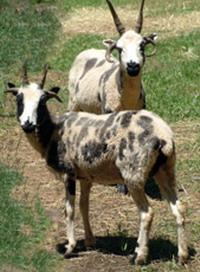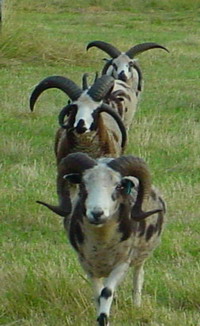
|
Details on How To Contribute to Brit-Am http://britam.org/contribute-Brit-Am.html |
Brit-Am Now no. 1858: Ten Tribes Studies.
15 April 2012, 23 Nissan 5772
Contents:
1. Jacob's Sheep: A point of interest?
Interesting extracts from two articles.
2. Resurrection and Eternal Life. Addition to Article.
3. THE SAMARITANS.
Do traditions of British and French Kinship Reflect Ancestral Connections?
|
Brit-Am Discussion Group |
Contents by Subject |
Research Recognition Reconciliation Contribute |
|
Site Map Contents in Alphabetical Order |
This Site |
|
1. Jacob's Sheep: A point of interest? Interesting extracts from two articles. Source of Pictures: http://www.jsba.org
Is the Jacob Sheep the same breed that Jacob the patriarch had? Were they also in Scandinavia? How did they get to England? Why do they have Tay-Sachs disease which is otherwise peculiar to Ashkenazi Jews and French Canadians? (a) Article One. Jacob (sheep) http://en.wikipedia.org/wiki/Jacob_(sheep) Extracts: The Jacob sheep is a rare breed of small, piebald (colored with white spots), polycerate (multi-horned) sheep. Jacobs may have from two to six horns, but most commonly have four. The most common color is black and white. Jacobs are usually raised for their wool, meat, and hides. They are also kept as pets and ornamental animals, and have been used as guard animals to protect farm property from theft or vandalism and defend other livestock against predators. Among the many accounts of ancient breeds of piebald sheep is the story of Jacob... According to the Book of Genesis (Genesis 30:31'43), in what may be the earliest recorded attempt at selective breeding,[3] Jacob took every speckled and spotted sheep from his father-in-law's (Laban's) flock and bred them. The Jacob is named for the Biblical figure of Jacob.[1][4] The resulting breed may have accompanied the westward expansion of human civilization through Northern Africa, Sicily, Spain and eventually England.[2] However, it was not until the 20th century when the breed acquired the name "Jacob sheep".[5] A limited amount of circumstantial evidence from the historical record lends support to a related theory that the Jacob is a descendant of the fat-tailed sheep, another ancient breed from Mesopotamia.[6 The Jacob is a small, multi-horned, piebald sheep that resembles a goat in its conformation. However, it is not the only breed that can produce polycerate or piebald offspring. Other polycerate breeds include the Hebridean, Icelandic, Manx Loaghtan, and the Navajo-Churro, and other piebald breeds include the Finnsheep and the West African Dwarf. ... the American Jacob has retained nearly all of the original phenotypic characteristics of its Old World ancestors while its British counterpart has lost many of its unimproved physical characteristics through cross-breeding and selective breeding. The British Jacob has thus diverged from the American Jacob as a result of artificial selection.[ Tay'Sachs disease is one of several related genetic disorders in humans... Tay'Sachs disease is characterized by progressive deterioration of mental and physical abilities, usually resulting in death by the age of four years.[23] Recent research has revealed that this entity exists in some flocks of Jacob sheep. [Note Tay-Sachs Disease is especially associated with Ashknazai Jews and French Canadians!] (b) Article Two. Spot On: Jacob Sheep--a Unique Sheep Breed http://www.hobbyfarms.com/livestock-and-pets/unique-sheep-breed-14784.aspx Extracts: Jacob sheep originated in what is now Syria and Iraq, more than 3,000 years ago. One of the oldest sheep breeds, the Jacob is named for the Biblical father of the 12 Hebrew tribes. Jacob, son of Isaac, was the first person in recorded history to practice selective breeding of livestock. 'Unlike many other ancient breeds, the Jacob has not been improved to satisfy the commercial marketplace,' says Fenton. Jacobs have a more primitive body shape, are fine boned and yield a lean carcass with very little external fat. Carcass yield is very high, compared with more improved breeds; there is very little waste. 'Ewes need less supplemental feed than other sheep during times of nutritional stress, and usually lamb with no assistance. Newborn lambs are very vigorous, up and nursing quickly without help,' says Fenton. Jacob ewes are included in many commercial flocks in England because of their hardiness, ease of lambing, strong mothering instinct and very little need of the shepherd's time and assistance. The advantages of the Jacob sheep in a commercial operation are actually the very characteristics that make them an 'unimproved' breed. They are small and hardy, economical to feed and have few health problems. On pasture, stocking rates for Jacobs are about six sheep per acre, compared to about five per acre with the larger breeds. The small, fine-boned Jacob has no lambing problems in contrast with the improved breeds that often need birthing assistance. Jacob ewes are also good mothers, and often have twins and occasional triplets. In England, where there are more Jacobs, the ewes are often bred to large mutton rams to produce larger, early maturing, lean-market lambs. 'The ewes are more economical to keep than the same number of a larger breed,' explains Painter. 'Jacob rams are also used on yearling commercial ewes, to help ensure less lambing problems.' Breeders who raise Jacobs find them highly marketable as breeding stock, and for their many products. Farm sales of freezer lamb, tanned pelts, hand-spinner fleeces, exotic horns for making walking sticks, buttons and various ornaments can bring breeders additional income. The uniqueness of these sheep gives many breeders a great deal of satisfaction, for Jacobs can be bred to exhibit a specific look to suit each owner's personal preference; percentage of color, two horns or four, spotted legs or white legs, large spots or small. Breeders can craft their own flock just the way they want it and not quite the same as anyone else's. This genetic diversity is part of the breed's appeal and may help assure its continuity. 2. Resurrection and Eternal Life. Addition to Article. We have added to our article, Reward in the Next World is the Main Thing! http://www.britam.org/Proverbs/Proverbs8.html#4 Added Headings include: Both Resurrection and Eternal Life are Predicted! Life in Eternity Promised to David. A Future Dwelling Amongst the Angels Promised to the High Priest Joshua. David will join his son in the Next Life. Isaiah Spoke of a Resurrection of the Dead. Note: The article was an outgrowth of our commentary to Proverbs. It is an important subject but not something we wish to focus on. Our main concern is and should be the Ten Tribes, their Identification, and everything (and anything) directly connected with it. 3. THE SAMARITANS. Do traditions of British and French Kinship Reflect Ancestral Connections? Article Upgraded somewhat, different pictures introduced. http://www.britam.org/samaritans.html |
The Tribes - 4th Edition Full Cover Spread.
http://www.britam.org/TribesCover.html

|
All truth passes through three
stages: First it is ridiculed. Second, it is violently opposed. Third, it is accepted as being self-evident. Arthur Schopenhauer (1788-1860). |
To Make an Offering to Brit-Am!
http://www.britam.org/contribute-Brit-Am.html
Previous Issues

Pleased with what you read?
Click Here to make an offering. |
'It is impossible to rightly govern the world without
God or the Bible.'
George Washington
Brit-Am is the "still small voice" that contains the truth.
"after the earthquake a fire, but the LORD was not in the fire; and after the fire a still small voice"
[1-Kings 19:12].
 |


